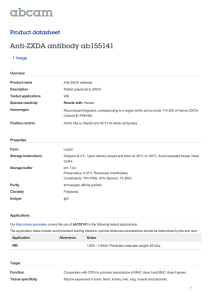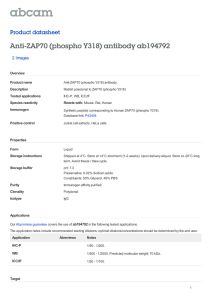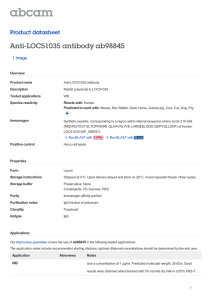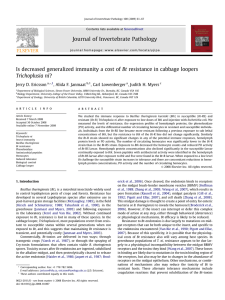Anti-BTK (phospho Y550) antibody ab52192 Product datasheet 1 References 2 Images
advertisement
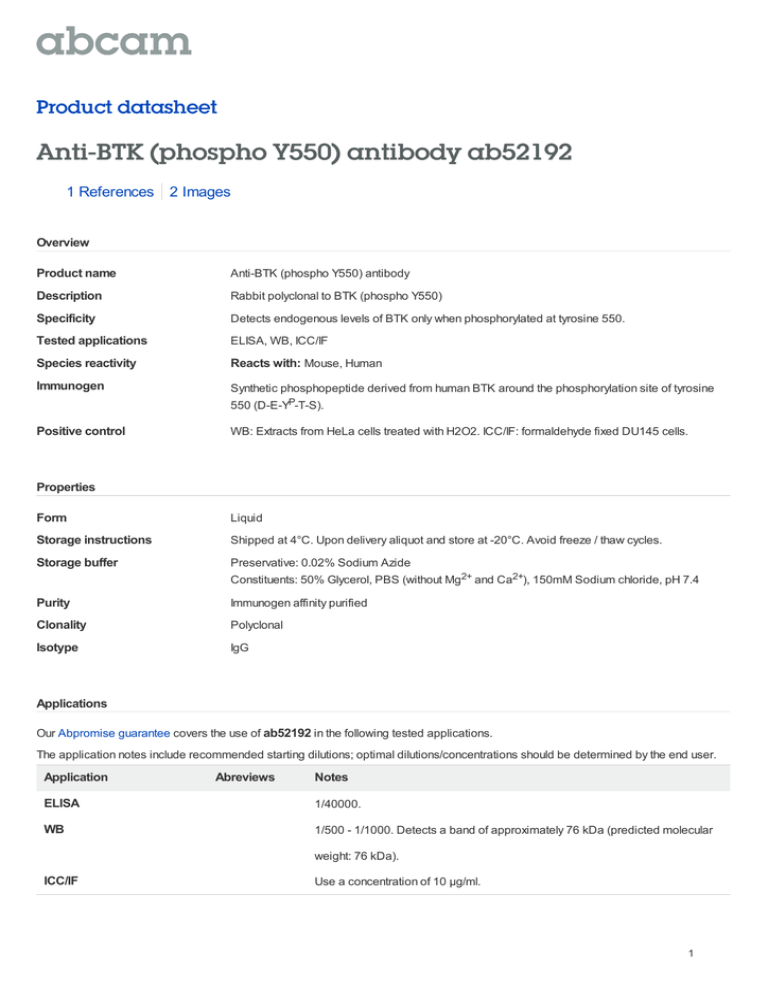
Product datasheet Anti-BTK (phospho Y550) antibody ab52192 1 References 2 Images Overview Product name Anti-BTK (phospho Y550) antibody Description Rabbit polyclonal to BTK (phospho Y550) Specificity Detects endogenous levels of BTK only when phosphorylated at tyrosine 550. Tested applications ELISA, WB, ICC/IF Species reactivity Reacts with: Mouse, Human Immunogen Synthetic phosphopeptide derived from human BTK around the phosphorylation site of tyrosine 550 (D-E-YP-T-S). Positive control WB: Extracts from HeLa cells treated with H2O2. ICC/IF: formaldehyde fixed DU145 cells. Properties Form Liquid Storage instructions Shipped at 4°C. Upon delivery aliquot and store at -20°C. Avoid freeze / thaw cycles. Storage buffer Preservative: 0.02% Sodium Azide Constituents: 50% Glycerol, PBS (without Mg2+ and Ca2+), 150mM Sodium chloride, pH 7.4 Purity Immunogen affinity purified Clonality Polyclonal Isotype IgG Applications Our Abpromise guarantee covers the use of ab52192 in the following tested applications. The application notes include recommended starting dilutions; optimal dilutions/concentrations should be determined by the end user. Application Abreviews Notes ELISA 1/40000. WB 1/500 - 1/1000. Detects a band of approximately 76 kDa (predicted molecular weight: 76 kDa). ICC/IF Use a concentration of 10 µg/ml. 1 Target Function Plays a crucial role in B-cell ontogeny. Transiently phosphorylates GTF2I on tyrosine residues in response to B-cell receptor cross-linking. Required for the formation of functional ARID3A DNAbinding complexes. Involvement in disease Defects in BTK are the cause of X-linked agammaglobulinemia (XLA) [MIM:300755]; also known as X-linked agammaglobulinemia type 1 (AGMX1) or immunodeficiency type 1 (IMD1). XLA is a humoral immunodeficiency disease which results in developmental defects in the maturation pathway of B-cells. Affected boys have normal levels of pre-B-cells in their bone marrow but virtually no circulating mature B-lymphocytes. This results in a lack of immunoglobulins of all classes and leads to recurrent bacterial infections like otitis, conjunctivitis, dermatitis, sinusitis in the first few years of life, or even some patients present overwhelming sepsis or meningitis, resulting in death in a few hours. Treatment in most cases is by infusion of intravenous immunoglobulin. Defects in BTK may be the cause of X-linked hypogammaglobulinemia and isolated growth hormone deficiency (XLA-IGHD) [MIM:307200]; also known as agammaglobulinemia and isolated growth hormone deficiency or Fleisher syndrome or isolated growth hormone deficiency type 3 (IGHD3). In rare cases XLA is inherited together with isolated growth hormone deficiency (IGHD). Sequence similarities Belongs to the protein kinase superfamily. Tyr protein kinase family. TEC subfamily. Contains 1 Btk-type zinc finger. Contains 1 PH domain. Contains 1 protein kinase domain. Contains 1 SH2 domain. Contains 1 SH3 domain. Post-translational modifications Autophosphorylated on Tyr-223 and Tyr-551. Phosphorylation of Tyr-223 may create a docking site for a SH2 containing protein. Cellular localization Cytoplasm. Membrane. Nucleus. Anti-BTK (phospho Y550) antibody images All lanes : Anti-BTK (phospho Y550) antibody (ab52192) at 1/500 dilution Lane 1 : extracts from HeLa cells, treated with H2O2 Lane 2 : extracts from HeLa cells, treated with H2O2 with blocking peptide Predicted band size : 76 kDa Observed band size : 76 kDa Western blot - BTK (phospho Y550) antibody (ab52192) 2 ICC/IF image of ab52192 stained DU145 cells. The cells were 4% formaldehyde fixed (10 min) and then incubated in 1%BSA / 10% normal goat serum / 0.3M glycine in 0.1% PBS-Tween for 1h to permeabilise the cells and block non-specific protein-protein interactions. The cells were then incubated with the antibody ab52192 at 10µg/ml overnight at +4°C. The secondary antibody (green) was DyLight® 488 goat anti- rabbit (ab96899) IgG (H+L) used at a 1/1000 Immunocytochemistry/ Immunofluorescence Anti-BTK (phospho Y550) antibody (ab52192) dilution for 1h. Alexa Fluor® 594 WGA was used to label plasma membranes (red) at a 1/200 dilution for 1h. DAPI was used to stain the cell nuclei (blue) at a concentration of 1.43µM. Please note: All products are "FOR RESEARCH USE ONLY AND ARE NOT INTENDED FOR DIAGNOSTIC OR THERAPEUTIC USE" Our Abpromise to you: Quality guaranteed and expert technical support Replacement or refund for products not performing as stated on the datasheet Valid for 12 months from date of delivery Response to your inquiry within 24 hours We provide support in Chinese, English, French, German, Japanese and Spanish Extensive multi-media technical resources to help you We investigate all quality concerns to ensure our products perform to the highest standards If the product does not perform as described on this datasheet, we will offer a refund or replacement. For full details of the Abpromise, please visit http://www.abcam.com/abpromise or contact our technical team. Terms and conditions Guarantee only valid for products bought direct from Abcam or one of our authorized distributors 3
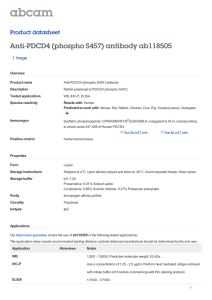
![Anti-Flt3 / CD135 (phospho Y589) antibody [EPR2311(2)]](http://s2.studylib.net/store/data/012443841_1-dd260e2a8c5221ee2198310004f7d91c-300x300.png)
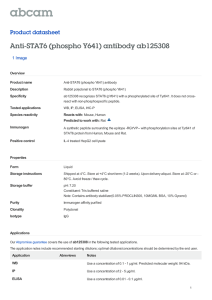
![Anti-Flt3 / CD135 (phospho Y591) antibody [EPR2159(2)]](http://s2.studylib.net/store/data/012443842_1-ed39a172dc295f5ee78e5407b7858059-300x300.png)
